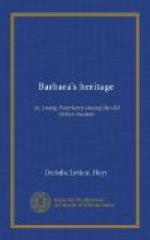The romantic mystery of Masaccio’s short life and sudden, secret death, and the wonderful advance that he effected in the evolution of Italian painting of the fifteenth century, had greatly interested them as they had read at home about him, and all were eager to see the frescoes.
“They are somewhat worn and dark,” Mr. Sumner said, “and at first you will probably feel disappointed. What you must particularly look for here is that which you have hitherto found nowhere else,—the expression of individuality in figures and faces. Giotto, you remember, sought to tell some story; to illustrate some Bible incident so that it should seem important and claim attention. Masaccio went to work in a wholly different way. While Giotto would say to himself: ’Now I am going to paint a certain Bible story; what people shall I introduce so that this story shall best seem to be a real occurrence?’ Masaccio would think: ’I wish to make a striking picture of Peter and John, or any other sacred characters. What story or incident shall I choose for representation that will best show the individual characteristics of these men?’
“Possessing this great love for people, he studied the drawing of the human figure as had never been done before in the history of Christian art. At this time, more than a hundred years after Giotto, artists were beginning to master the science of perspective drawing, and in Masaccio’s pictures we see men standing firmly on their feet, and put upon different planes in the same picture; their figures well poised, and true to anatomy. In one of them is his celebrated naked, shivering youth, who is awaiting baptism,—the study of which wrought a revolution in painting.”
A little afterward they were standing in the dim Brancacci Chapel of Santa Maria del Carmine, whose walls are covered with frescoes of scenes in the lives of Christ and His apostles. They had learned that there was an artist called Masolino, who, perhaps, had begun these frescoes, and had been Masaccio’s teacher; and that a young man called Filippino Lippi had finished them some years after they had been left incomplete by Masaccio’s early death.
All were greatly impressed by the fact that so little can be known of Masaccio, who wrought here so well; that even when, or how, or where he died is a mystery; and yet his name is one of the very greatest in early Italian art.
They talked of how the greatest masters of the High Renaissance—Michael Angelo, Leonardo da Vinci, and Raphael—used to come here to study, and thus this little chapel became a great art school; and how, at the present time, it is esteemed by many one of the four most important art-buildings in the world;—the others being, Arena Chapel, Padua, where are Giotto’s frescoes; Sistine Chapel, Rome, where are Michael Angelo’s greatest paintings; and Scuola di San Rocco, Venice, which is filled with Tintoretto’s work.
He then called their attention to the composition of Masaccio’s frescoes; asking them especially to notice that, while only a few people are taking part in the principal scene, many others are standing about interested in looking on; all, men with strongly marked characteristics,—individual, and worthy of attention.




